Overview
In the competitive landscape of e marketplaces, manufacturers face significant challenges that can hinder their success. To thrive, it is essential to adopt effective strategies. This article outlines five key strategies that can propel manufacturers forward:
- Optimizing product listings
- Enhancing visibility
- Utilizing data analytics
- Cultivating strong customer relationships
Evidence supports the notion that effective listing optimization, data-driven decision-making, and exceptional customer service are not just beneficial but crucial for improving sales performance and gaining a competitive edge. By implementing these strategies, manufacturers can navigate the rapidly growing e-commerce environment with confidence. Explore these insights further to unlock your potential in the digital marketplace.
Introduction
The e-marketplace landscape is undergoing rapid evolution, presenting formidable challenges alongside lucrative opportunities for manufacturers. With leading platforms like Amazon Business and Alibaba at the forefront, grasping the nuances of each marketplace is essential for achieving success.
This article explores five critical strategies that manufacturers can implement to enhance visibility, optimize product listings, leverage data analytics, and cultivate strong customer relationships, ultimately positioning themselves for success in a competitive digital environment.
How can manufacturers effectively navigate this complex terrain to not only survive but thrive amidst the competition?
Understand the E-Marketplace Landscape
The e marketplaces landscape presents significant challenges and opportunities, characterized by diverse platforms such as Amazon Business, Alibaba, and specialized industry-specific marketplaces. Manufacturers must meticulously evaluate each platform's audience, fees, and features to identify the optimal fit for their products. Understanding the competitive dynamics and on e marketplaces is paramount.
For example, Amazon Business boasts an impressive reach, capturing 14.06% of all eCommerce store visits globally, while niche e marketplaces may offer superior targeting for specialized equipment. Furthermore, with mobile commerce projected to comprise 44.2% of all e-commerce sales by 2025, optimizing for mobile users becomes increasingly crucial.
Manufacturers should also scrutinize marketplace policies, including return processes and customer service expectations, as these factors can profoundly influence their operations and customer satisfaction. As the global eCommerce market is anticipated to reach $7.4 trillion by 2025, driven by enhanced internet accessibility—particularly in Africa and Southeast Asia—producers who proactively adapt to these shifts will be better positioned to thrive in an increasingly competitive environment.
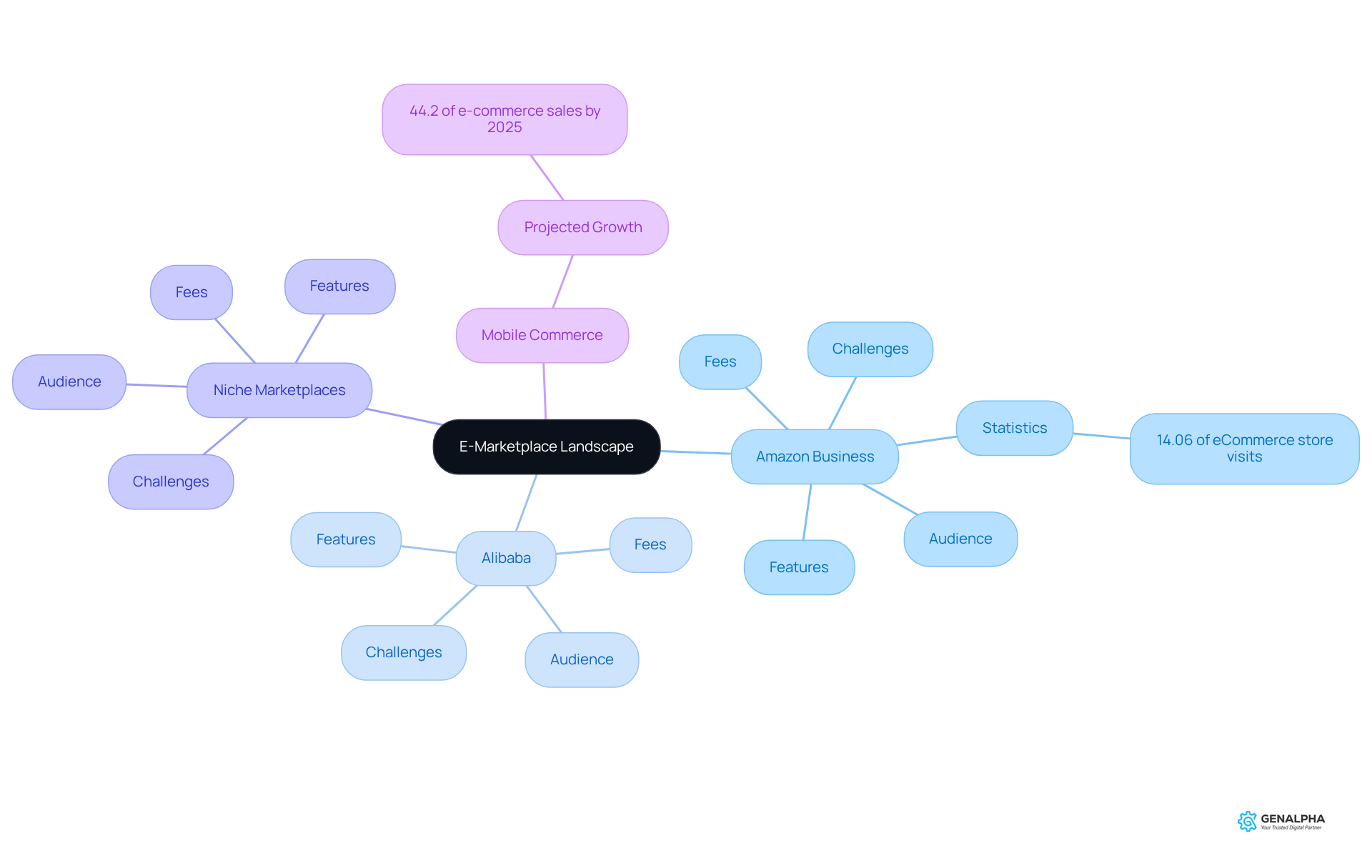
Implement Effective Visibility Strategies
To enhance visibility in e marketplaces, manufacturers must adopt a comprehensive strategy that includes several key tactics. Optimizing item titles and descriptions with relevant keywords is essential, as this directly impacts searchability and discoverability. Research indicates that effective listing optimization can lead to significant increases in sales within e marketplaces, with B2C ecommerce projected to reach $5.5 trillion by 2027, underscoring the importance of optimization. Moreover, high-quality images are crucial; they not only attract attention but can significantly influence purchasing decisions. Utilizing promotional tools, such as sponsored listings on e marketplaces, can further enhance visibility, enabling creators to position their offerings prominently in search results.
Participating in social media promotion and focused email campaigns can drive additional traffic to item listings. For instance, a producer may execute a targeted advertising campaign on LinkedIn, aimed at decision-makers in the equipment industry, which can result in enhanced visibility and potential revenue. Notably, 33% of online consumers discover items through social media, highlighting the effectiveness of this approach. Additionally, engaging in e marketplaces through promotions and seasonal events can leverage increased consumer interest during peak shopping times, significantly enhancing product visibility. With , the potential impact of such promotions is substantial.
The effects of these optimization strategies are profound; companies that actively refine their listings and engage in promotional activities often observe rising conversion rates, illustrating the direct correlation between visibility and sales performance. By implementing these strategies, producers can effectively strengthen their presence in competitive online environments.
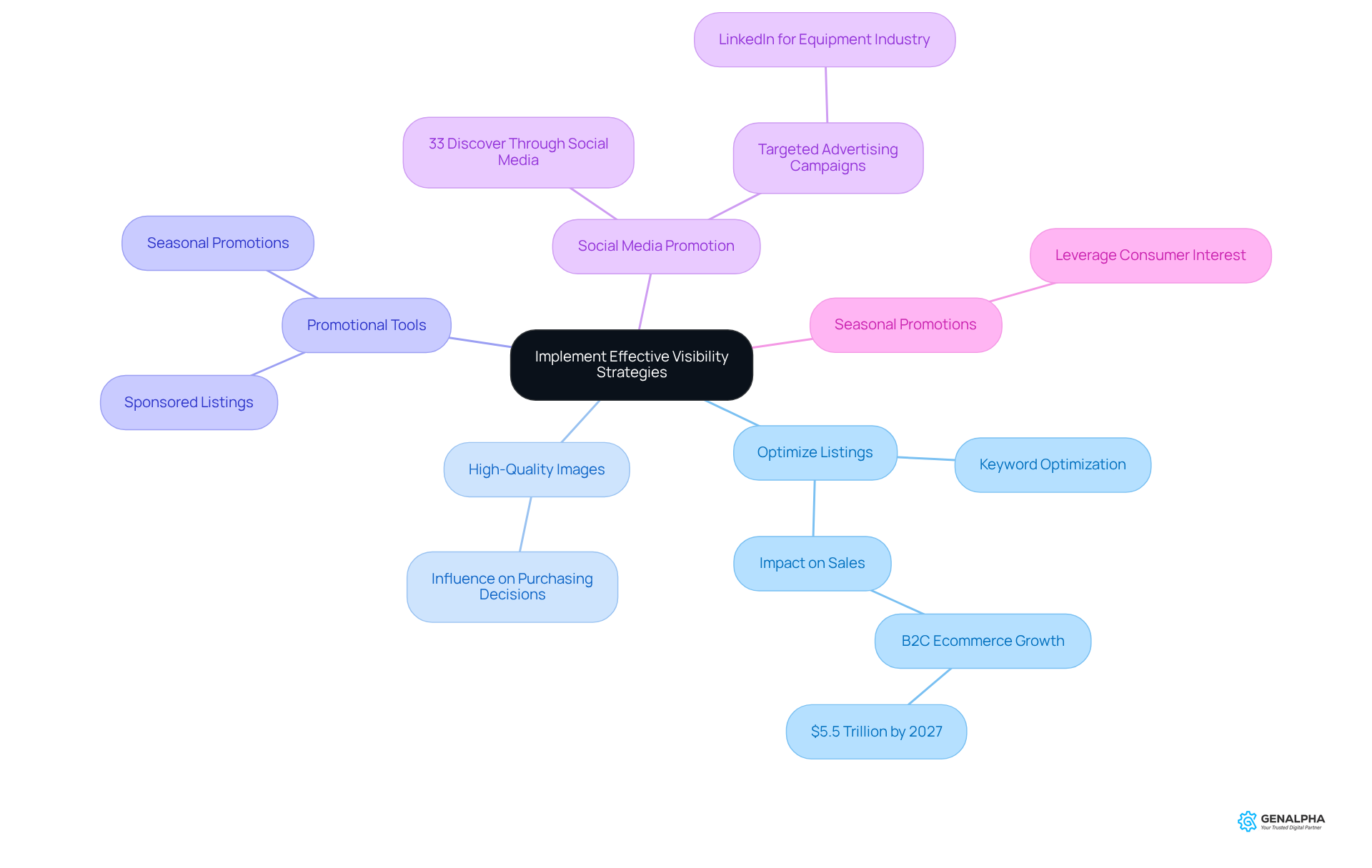
Optimize Product Listings for Maximum Impact
To maximize the impact of listings, manufacturers must prioritize several essential elements.
- Product titles must be clear and descriptive, incorporating relevant keywords that potential buyers are likely to use in their searches. This approach not only enhances visibility but also aligns with client expectations. As Neil Patel emphasizes, producing valuable content that captivates clients is crucial for brand identity and can significantly influence purchasing decisions.
- Comprehensive item descriptions are vital; they should effectively showcase features, benefits, and specifications, providing prospective buyers with the information they need to make informed choices. Research indicates that listings featuring high-quality images and detailed descriptions can improve conversion rates significantly, underscoring the importance of investing in these elements. For instance, a study found that listings with high-quality images can lead to a conversion rate increase of up to 30%.
- High-quality images play a pivotal role in attracting clients. Images should highlight the item from various perspectives and include lifestyle photos when relevant, as these visuals help buyers envision the item in their own environment. Furthermore, incorporating videos can significantly enhance buyer confidence. For example, a producer of industrial machinery could create a video showcasing the equipment in operation, resulting in increased conversion rates by providing a concrete sense of its functionality and effectiveness. Jeff Bezos notes that an excellent client experience fosters word-of-mouth marketing, which remains a powerful advertising method.
By focusing on these strategies, manufacturers can create engaging listings that resonate with online buyers on e marketplaces and drive revenue. This aligns with GenAlpha's mission to to thrive in the digital landscape by leveraging e marketplaces to streamline operations and foster growth in a competitive marketplace.
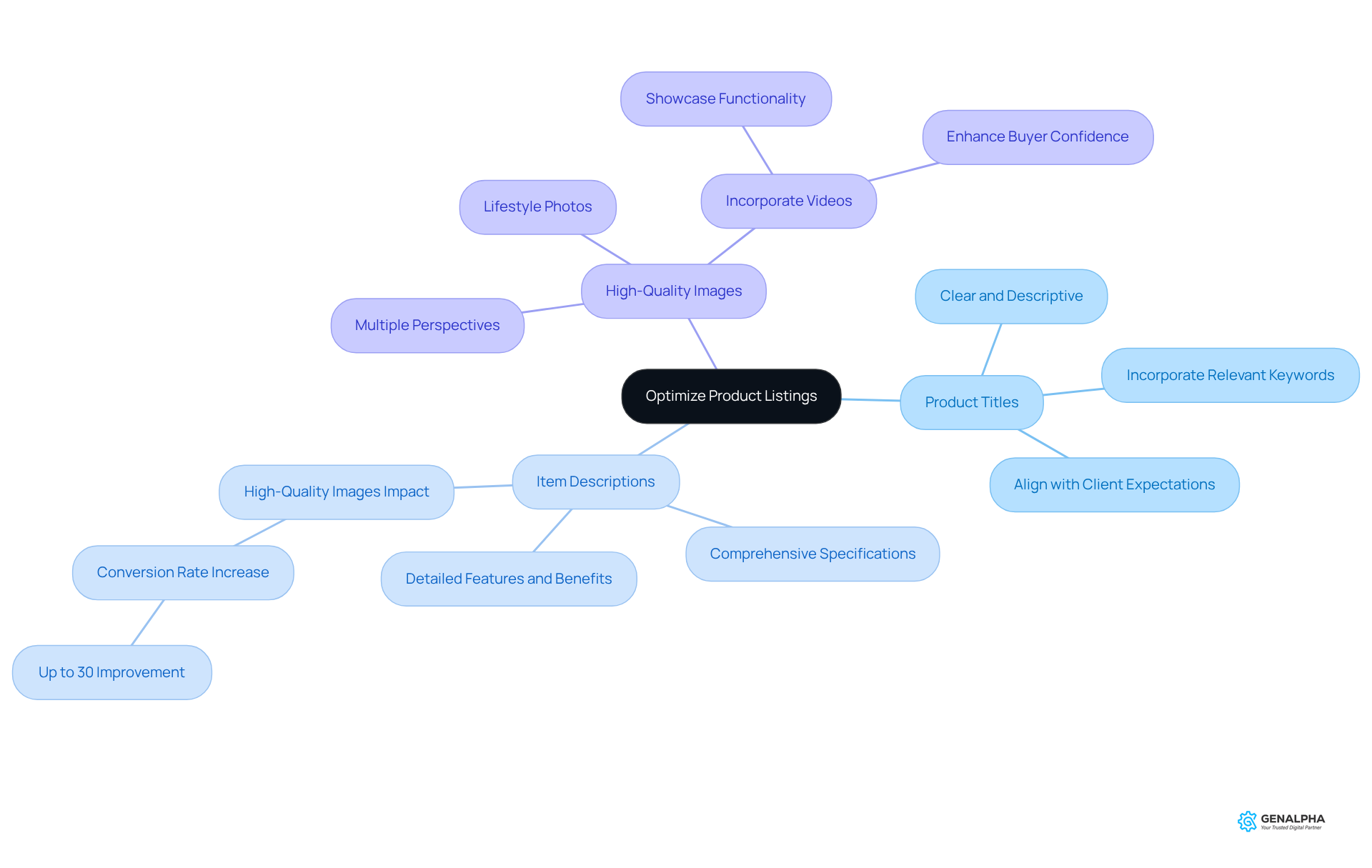
Utilize Data Analytics for Informed Decision-Making
Manufacturers face significant challenges in understanding consumer behavior, sales trends, and inventory management. To overcome these hurdles, they must harness the power of data analytics, which provides critical insights into e marketplaces performance. By analyzing this data, manufacturers can pinpoint which items excel and which fall short, allowing for strategic adjustments that enhance overall performance. Tools such as Google Analytics and deliver invaluable information on demographics, purchasing patterns, and traffic sources.
For instance, if analytics reveal that a specific product garners substantial views but few purchases, producers can investigate potential issues related to pricing, product descriptions, or visibility. This data-oriented approach empowers producers to refine their products and marketing tactics, ultimately boosting sales performance and client satisfaction. Notably, data-driven organizations are 23 times more likely to acquire clients, and businesses leveraging big data report an 8 percent increase in profits. Furthermore, 69% of businesses have acknowledged improved strategic decisions due to big data, highlighting the essential role of analytics in informed decision-making.
GenAlpha Technologies stands at the forefront of this transformation, providing analytics tools that deliver data-driven insights for operational optimization. By integrating these solutions, producers can enhance their performance and navigate the complexities of the market more effectively. Embrace the power of data analytics today and unlock the potential for growth and success.
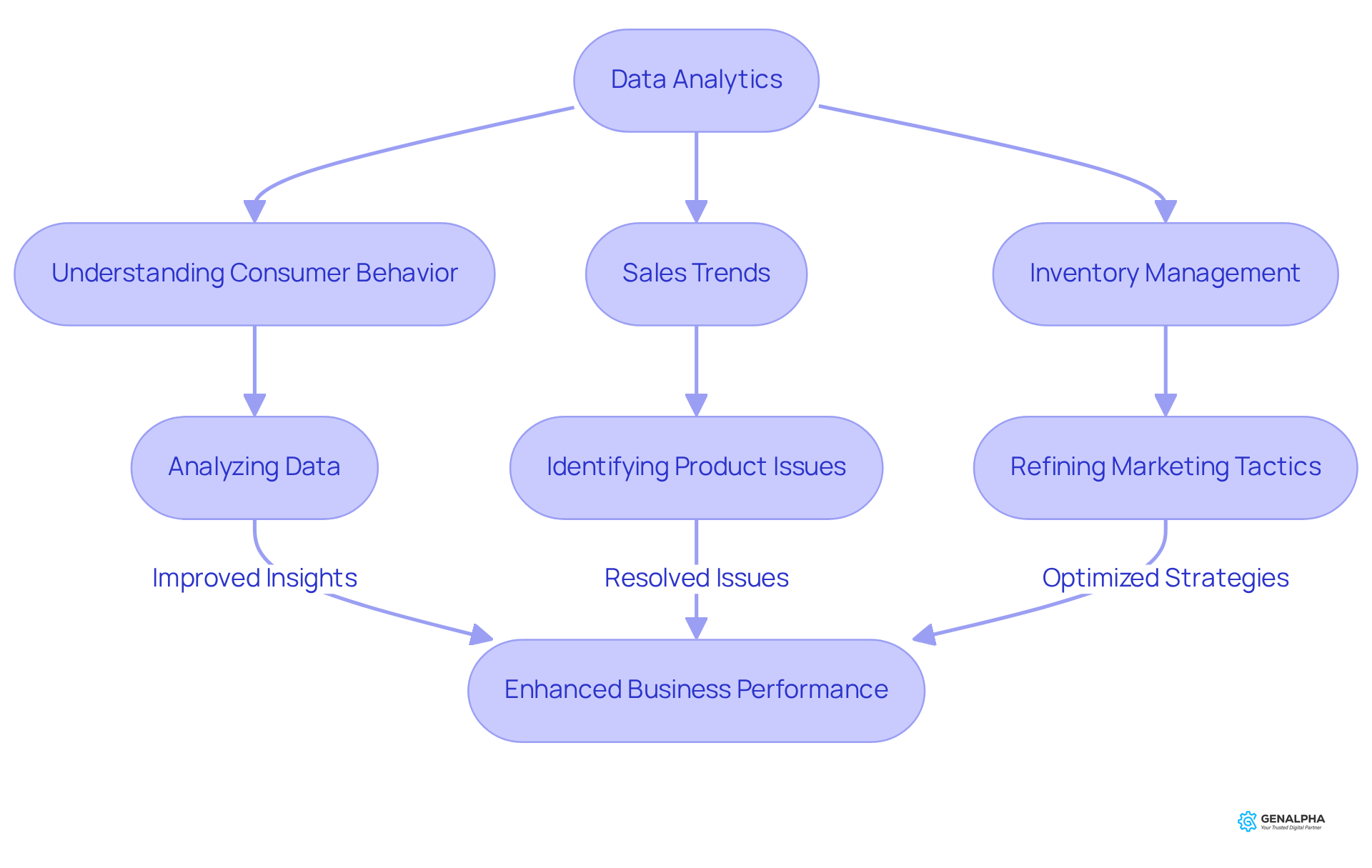
Cultivate Strong Customer and Partner Relationships
To foster robust connections with clients and partners, producers must prioritize and uphold transparent communication. This entails:
- Promptly addressing inquiries and concerns
- Delivering personalized experiences
- Actively soliciting feedback to refine their offerings
Establishing strategic partnerships within e marketplaces—such as collaborations with logistics providers and marketing agencies—can significantly enhance operational efficiency. For instance, partnering with a logistics provider can streamline shipping procedures, resulting in improved delivery times and heightened client satisfaction. Additionally, a study indicates that upsells occur three times more frequently with partners, underscoring the tangible benefits of strategic partnerships in e marketplaces.
Furthermore, implementing a relationship management (CRM) system enables manufacturers to monitor interactions and tailor marketing efforts to meet specific client needs, thus promoting loyalty and inspiring repeat purchases. As highlighted by industry insights, 93% of customers are more likely to make repeat purchases with companies that deliver excellent customer service, emphasizing the necessity of investing in these relationships for long-term success.
Sarah Wang, a partner at Andreessen Horowitz, underscores that partnerships are crucial for generating pipeline and enhancing conversion rates, reinforcing the importance of collaboration in achieving business objectives.
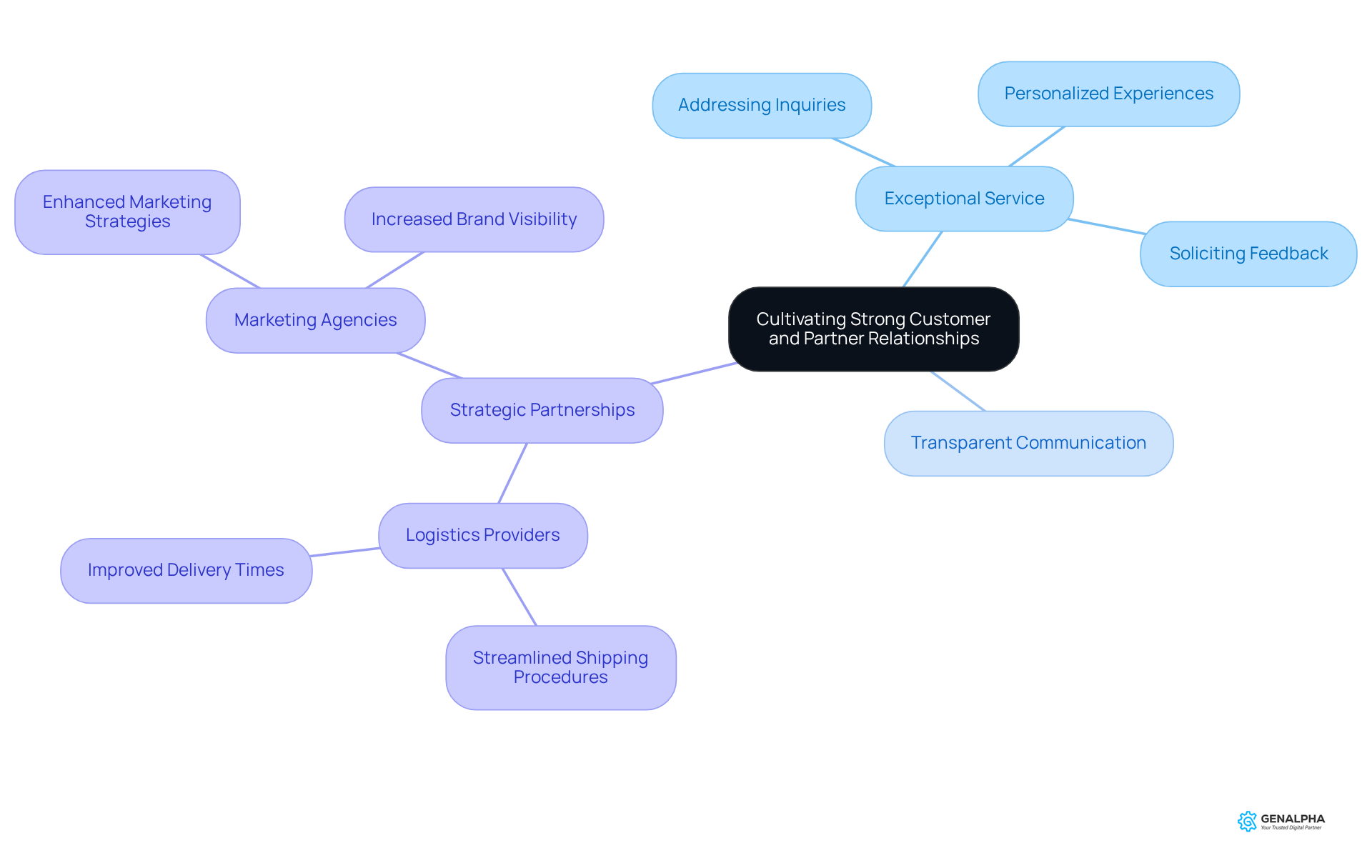
Conclusion
In today's competitive e-marketplace landscape, manufacturers face significant challenges that require strategic approaches to thrive. By comprehensively understanding the unique characteristics of various platforms, optimizing product visibility, and leveraging data analytics, manufacturers can substantially enhance their presence and drive sales. The cultivation of strong customer and partner relationships further underscores the critical importance of exceptional service and transparent communication in achieving long-term success.
Key strategies include:
- The necessity of thorough market research to pinpoint the most effective platforms.
- The significance of optimizing product listings with compelling descriptions and high-quality images.
- The power of data analytics in informing sound business decisions.
- Fostering partnerships and maintaining robust customer relationships as vital components that contribute to improved operational efficiency and increased customer loyalty.
Ultimately, embracing these strategies positions manufacturers for success in e marketplaces and empowers them to adapt to the evolving digital landscape. As the e-commerce market continues to expand, manufacturers are urged to take proactive steps, leveraging the insights and tools at their disposal to enhance performance and ensure sustainable growth in this dynamic arena.
Frequently Asked Questions
What is the e-marketplace landscape, and what challenges does it present?
The e-marketplace landscape includes diverse platforms such as Amazon Business and Alibaba, presenting both challenges and opportunities. Manufacturers must evaluate each platform's audience, fees, and features to find the best fit for their products while understanding competitive dynamics and user expectations.
How significant is the reach of Amazon Business in the e-commerce market?
Amazon Business captures 14.06% of all eCommerce store visits globally, making it a significant player in the e-marketplace landscape.
Why is mobile optimization important for e-commerce?
Mobile commerce is projected to account for 44.2% of all e-commerce sales by 2025, making it crucial for manufacturers to optimize their offerings for mobile users.
What marketplace policies should manufacturers consider?
Manufacturers should scrutinize marketplace policies regarding return processes and customer service expectations, as these can significantly influence their operations and customer satisfaction.
What is the projected growth of the global eCommerce market by 2025?
The global eCommerce market is anticipated to reach $7.4 trillion by 2025, driven by improved internet accessibility, especially in Africa and Southeast Asia.
What strategies can manufacturers use to enhance visibility in e marketplaces?
Manufacturers can enhance visibility by optimizing item titles and descriptions with relevant keywords, using high-quality images, utilizing promotional tools like sponsored listings, and engaging in social media promotion and email campaigns.
How does listing optimization affect sales in e marketplaces?
Effective listing optimization can lead to significant increases in sales, as it directly impacts searchability and discoverability.
What role do promotional tools play in enhancing product visibility?
Promotional tools, such as sponsored listings, help position offerings prominently in search results, enhancing visibility and potentially increasing sales.
How can social media influence product discovery?
Approximately 33% of online consumers discover items through social media, making it an effective channel for driving traffic to item listings.
What is the expected mobile e-commerce revenue in the US by 2025?
Mobile e-commerce revenue in the US is expected to reach $710 billion by 2025, indicating the substantial impact of mobile optimization and promotions.
What is the correlation between visibility strategies and sales performance?
Companies that actively refine their listings and engage in promotional activities often observe rising conversion rates, demonstrating a direct correlation between visibility and sales performance.




